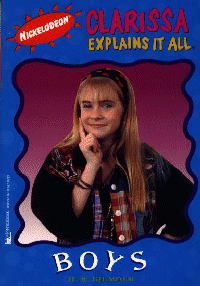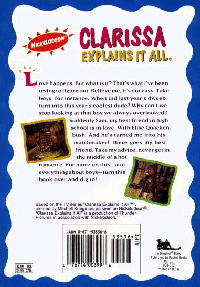
Note: This site is no longer being maintained, unfortunately. Most of the pages haven't been modified for years. See the homepage for the only part of this site that is being kept up to date.
jump to bottom of page

The popularity of Clarissa Darling/Melissa Joan Hart as an advisor to the young is well-known. Many sage pieces of advice were delivered in Clarissa Explains it All, and Miss Hart's advice column is a regular feature in the magazine Teen Beat. The book ``Clarissa Explains it All: Boys,'' by H.B. Gilmour, is another example of Clarissa's advice-giving abilities.
This little book contains adaptations of four CEIA episodes. In order of appearance in the book, they are:
(If you aren't familiar with these episodes, you can find summaries by selecting their respective links.)
This book, bearing the imprimatur of Nickelodeon/Viacom, is an interesting repackaging of the four episodes. The author has taken the scripts (obviously from official sources) and adapted them to short-story format. There is some introductory, non-episode material in the front commenting on the unpredictability of love and the male species. Then there are four chapters, each devoted to an adaptation of one of the episodes. The chapters vary in how faithfully the episodes are adapted. Clarissa's monologues to the camera are rendered in narrative form. Finally, there is an epilogue, to sum up the concepts presented in the book.
But there is more than that. Many of the scenes in the episodes are expanded upon. We are given insight into what the fictional Clarissa might be thinking about or contemplating as she ``experiences'' the various sequences. For instance, consider the following scene from ``A Little Romance.'' This is one of the bits where Clarissa is imagining what it would be like to be in a serious relationship with Sam. She imagines that they are in an Italian restaurant, sharing a plate of pasta. In the TV episode, we see them slurping up what turns out to be opposite ends of the same strand of pasta. In ``CEIA:B'', this scene is rendered thus:
What would we do, where would we go? All I could picture was the spaghetti scene from Lady and the Tramp . Only it was Sam and me in a cozy Italian restaurant, our table covered with a red-and-white checkered cloth.
By the light of a candle stuck in a Chianti bottle, we'd look into each other's eyes, oblivious to everything else around us. We'd share a plate of pasta. Chew gently on our spaghetti only to realize as we came face to face, nose to nose, that we were chewing on the same slender piece of spaghetti. And as the chewing drew us closer together, we'd... almost... kiss?!?
A date with Sam. Mama mia, I thought, what am I going to do?
Those who are conversant with ``A Little Romance'' will recognize that last sentence as one of Clarissa's lines. But note how the scene has been expanded upon. It has been given more depth, additional nuances. And, of course, the description of the shared pasta dinner is taken directly from the episode.
Interspersed here and there are paragraphs intended to give advice to the young reader on one point or another. These are set off from the main text by using a different typeface and margins. An example of this comes directly after the paragraphs quoted above:
Inquiring Minds Want to Know. Dating. What is it, why is it, and what do you do when it happens to you? A great date is kind of like winning the lottery. Given the population of the world as measured against the number of people you actually go out with, the odds are against you. And if your date happens to be someone you like but someone who just doesn't set off fireworks or ring bells for you, the odds go down from there. Should you go out with a guy to avoid hurting his feelings? Of course not. But Sam's not ``a guy,'' he's my best friend. We're so close that when he gets a splinter, I feel like hollering ``Ouch!'' I didn't want to hurt Sam by turning him down. I didn't want to turn into that splinter. So Sam and I went out on our... I can't even say it. We went out. How did it go? It was good. It was bad. It got ugly.
More lines from the episode make their appearance! And the references to fireworks and bells also remind us of bits and pieces from the episode: the electronic paintbox overlays of the fizzled firecracker and the cracked bell.
This book can be thought of in two different ways. The first is as an attempt to wring a few more dollars out of some old CEIA scripts by changing them slightly and repackaging them in a form that will directly appeal to CEIA's young audience. The second is as a somewhat successful short-story-ization of four CEIA episodes, bearing in mind that just as a book suffers when it is turned into a movie or TV show, so do these CEIA episodes lose something in their conversion to print.
As mentioned above, the book starts out with an introduction, entitled ``Clarissa Explains it All.'' It is narrated, as is the entire book, by none other than Clarissa Marie Darling herself.
In the first chapter, ``Can't Live with Them, Can't Live without Them,'' Clarissa, introduces us to herself and the rest of her family. And, of course, Sam.This leads into the rendering of the episode ``Sam In Love''. The chapter follows the TV episode somewhat closely, including most of the amusing sub-plot of the search for Ferguson's lost birth certificate. The funny ``Boy King Ferdinand of Moldearia'' scene is included, but only as a device to set up Clarissa's humiliation upon learning that Sam has chosen Elise as his Mathalon partner. Marshall's attempts to design a doghouse for a very picky poodle are left out. And, the book places Clarissa and Sam in high school, while in the TV episode they are in junior high school.
Advice sections in this chapter include:
``Beware the Blow-Off,'' which explains what to do when your best friend falls in love (``Be patient. Don't take it personally.'') and ends with the line ``... but how come when you're not in love, it all looks like one big dork-fest?''
``Take My Advice - I'm Not Using It,'' which advises against ``getting in the middle of a dating couple's problems - even when you're invited'' and ends with ``When Dear Abby gets stuck in the middle of other people's problems, at least she gets the big bucks.'' (in the TV episode, it's ``at least she gets a paycheck'')
``Three into Two Doesn't Go,'' which is adapted from the ``Escape from the Tunnel of Love'' computer game. (``Picture it as a video game. There are three rowboats trying to get through the Tunnel of Love. Sam's rowboat's on the right. Elise's boat's on the left. And guess who's in the middle getting bumped every time they hit a rough spot? You got it!'')
The next chapter is ``To Thine Own Self be True,'' which contains ``Alter Ego.'' This version regrettably fails to include the wonderful sub-plot of Ferguson's temporary custody of William F. Buckley the cat (which, in the TV version, provides some most delightful scenes of Clarissa interacting with said feline). The introduction provides some material from the opening monologue (``Squeeze me into a pair of rattlesnake boots and a ten-gallon hat, and I'm your down-home, achy-breaky Clarissa.''). It then moves into the episode itself. The book alters the TV episode here and there. For instance, in the TV version, Clarissa is alone when she first converts herself to Jade, but in the book, Sam is also present.
Advice sections in this chapter include:
``O What a Tangled Web,'' which discusses the dangers of deceiving somebody (it might come back to haunt you later). ``I think it was Sir Walter Scott -- or maybe it was Snidely Whiplash -- who said 'O what a tangled web we weave when first we practice to deceive.'''
``Don't Try This at Home,'' on the difficulties of maintaining a facade for the person that one is trying to impress. ``There ought to be a warning label on experimenting with different personalities. I mean, it's fun, but look what happened to Dr. Frankenstein.''
The third chapter is ``Vive la Difference!'', which contains ``A Little Romance''. The chapter starts out with an adaptation of Clarissa's opening monologue. The scenes of Marshall and Janet in their hippie days (or should that be ``daze''?) that are in the opener are alluded to. We then dissolve to the episode. This one appears to be most faithful to the TV episode of the four chapters. The Rear Window subplot (about the mysteriously missing Edna Soaperstein) and the wonderful ``Disasterpiece Theatre'' segment are included. The one discordant note is that when Sam comes over for the first time after their ``date,'' Clarissa is described as folding her laundry; in the TV version, of course, she is doing nothing of the kind.
The one advice section in this chapter is ``Inquiring Minds Want to Know,'' quoted at length previously.
The last chapter is ``Love is Blind,'' which contains ``Blind Date.'' It starts off with a few words on how love is blind, but should dates be? The episode itself then begins. The very first paragraph of the episode portion shows that the difference between ``CEIA: B'' and the TV episodes in the sequence of the episodes is no accident. It reads
``A couple of months had passed since Sam and I had gone on our unforgettable date. The nightmare was behind us. We were friends again. Sometimes he'd phone me before climbing the ladder to my room. Sometimes he'd just pop in the way he always had.''
As all dedicated CEIA fans know, the blind date fiasco (``Blind Date'' [#139]) occurred BEFORE the Clarissa'n'Sam debacle (``A Little Romance'' [#147])! Be that as it may, the story generally follows the TV episode, complete with the subplot of Ferguson's attempts at obtaining justice for his parents against the neighbors and the dry cleaners. ``Blind Date Court'' and ``Blind Date from Hell'' (entitled ``Mystery Date from Beyond'' in the book) are there as well.
Advice sections in this chapter include:
``Just Say Go, '' which reprises the opening scene in the TV episode (``'Try Gee, Your Hair Sure Bounces!''').
``Winners and Losers,'' which is Clarissa's imagined scenes from the coffee shop with her date as she embarasses herself over a plate of food. (``Like, what if Milton's not a Sea Monkey -- but I am? If he's so cool, maybe I won't live up to his expectations!''
Finally, there is the epilogue, titled ``Boys... and Other Human Beings.'' It says that even though CEIA:B was written from a girl's point of view, it is just as applicable to the male gender. Both sexes share the same dubious opportunity to experience crushes, dating (``Small,'' as exemplified by ``A Little Romance,'' ``Regular,'' as exemplified by ``Sam in Love,'' and ``Weird,'' as exemplified by ``Alter Ego'') and, last but not least, regrets about the whole thing.
This little book fails to provide a complete picture of the subject at hand. To round it out, two more episodes should have been included. These are:
But it is understandable why these episodes were not included: the book is intended to provide a cheerful, positive (or as positive as can be expected) outlook on the subject matter.
The book's ISBN number is 0-671-53536-6. It is available from www.amazon.com.

Current section: Info Archives / Clarissa
Next page:
Clarissa's Little List Book
Previous page:
``Clarissa Day!''
[Info Archives] [Melissa] [Sabrina] [Clarissa] [Mailing List] [What's New?] [E-mail Me]